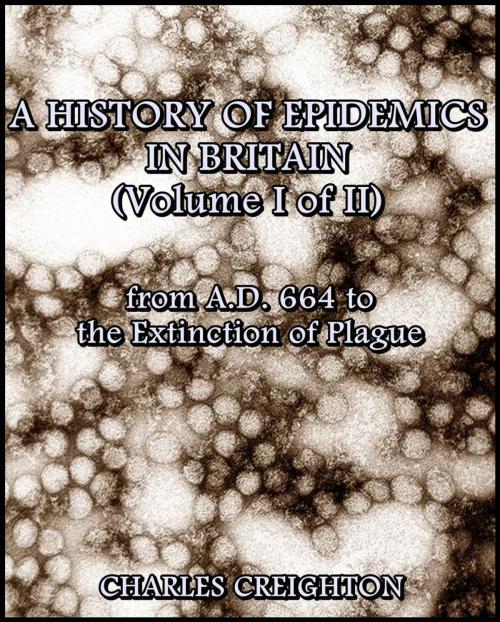A History of Epidemics in Britain (Volume I of II) : from A.D. 664 to the Extinction of Plague
Nonfiction, Health & Well Being, Medical, Ailments & Diseases, Infectious Diseases, Epidemiology, Reference, History, Diseases| Author: | Charles Creighton | ISBN: | 1230000219047 |
| Publisher: | C. J. CLAY, M.A. AND SONS | Publication: | February 16, 2014 |
| Imprint: | Language: | English |
| Author: | Charles Creighton |
| ISBN: | 1230000219047 |
| Publisher: | C. J. CLAY, M.A. AND SONS |
| Publication: | February 16, 2014 |
| Imprint: | |
| Language: | English |
A History of Epidemics in Britain (Volume I of II) : from A.D. 664 to the Extinction of Plague
The Middle Age of European history has no naturally fixed beginning or ending. The period of Antiquity may be taken as concluded by the fourth Christian century, or by the fifth or by the sixth; the Modern period may be made to commence in the fourteenth, or in the fifteenth or in the sixteenth. The historian Hallam includes a thousand years in the medieval period, from the invasion of France by Clovis to the invasion of Italy by Charles VIII. in 1494. We begin, he says, in darkness and calamity, and we break off as the morning breathes upon us and the twilight reddens into the lustre of day. To the epidemiologist the medieval period is rounded more definitely. At the one end comes the great plague in the reign of Justinian, and at the other end the Black Death. Those are the two greatest pestilences in recorded history; each has no parallel except in the other. They were in the march of events, and should not be fixed upon as doing more than their share in shaping the course of history. But no single thing stands out more clearly as the stroke of fate in bringing the ancient civilization to an end than the vast depopulation and solitude made by the plague which came with the corn-ships from Egypt to Byzantium in the year 543; and nothing marks so definitely the emergence of Europe from the middle period of stagnation as the other depopulation and social upheaval made by the plague which came in the overland track of Genoese and Venetian traders from China in the year 1347. While many other influences were in the air to determine the oncoming and the offgoing of the middle darkness, those two world-wide pestilences were singular in their respective effects: of the one, we may say that it turned the key of the medieval prison-house; and of the other, that it unlocked the door after eight hundred years.
The Black Death and its after-effects will occupy a large part of this work, so that what has just been said of it will not stand as a bare assertion. But the plague in the reign of Justinian hardly touches British history, and must be left with a brief reference. Gibbon was not insensible of the part that it played in the great drama of his history. “There was,” he says, “a visible decrease of the human species, which has never been repaired in some of the fairest countries of the globe.” After vainly trying to construe the arithmetic of Procopius, who was a witness of the calamity at Byzantium, he agrees to strike off one or more ciphers, and adopts as an estimate “not wholly inadmissible,” a mortality of one hundred millions. The effects of that depopulation, in part due to war, are not followed in the history. So far as Gibbon’s method could go, the plague came for him into the same group of phenomena as comets and earthquakes; it was part of the stage scenery amidst which the drama of emperors, pontiffs, generals, eunuchs, Theodoras, and adventurers proceeded. Even of the comets and earthquakes, he remarks that they were subject to physical laws; and it was from no want of scientific spirit that he omitted to show how a plague of such magnitude had a place in the physical order, and not less in the moral order.
A new science of epidemiology has sprung up since the time of Gibbon, who had to depend on the writings of Mead, a busy and not very profound Court physician. More particularly the Egyptian origin of the plague of the sixth century, and its significance, have been elucidated by the brilliant theory of Pariset, of which some account will be given at the end of the chapter on the Black Death. For the present, we are concerned with it only in so far as it may have a bearing upon the pestilences of Britain. The plague of the sixth century made the greatest impression, naturally, upon the oldest civilized countries of Europe; but it extended also to the outlying provinces of the empire, and to the countries of the barbarians. It was the same disease as the Black Death of the fourteenth century, the bubo-plague; and it spread from country to country, and lasted from generation to generation, as that more familiar infection is known to have done.
A History of Epidemics in Britain (Volume I of II) : from A.D. 664 to the Extinction of Plague
The Middle Age of European history has no naturally fixed beginning or ending. The period of Antiquity may be taken as concluded by the fourth Christian century, or by the fifth or by the sixth; the Modern period may be made to commence in the fourteenth, or in the fifteenth or in the sixteenth. The historian Hallam includes a thousand years in the medieval period, from the invasion of France by Clovis to the invasion of Italy by Charles VIII. in 1494. We begin, he says, in darkness and calamity, and we break off as the morning breathes upon us and the twilight reddens into the lustre of day. To the epidemiologist the medieval period is rounded more definitely. At the one end comes the great plague in the reign of Justinian, and at the other end the Black Death. Those are the two greatest pestilences in recorded history; each has no parallel except in the other. They were in the march of events, and should not be fixed upon as doing more than their share in shaping the course of history. But no single thing stands out more clearly as the stroke of fate in bringing the ancient civilization to an end than the vast depopulation and solitude made by the plague which came with the corn-ships from Egypt to Byzantium in the year 543; and nothing marks so definitely the emergence of Europe from the middle period of stagnation as the other depopulation and social upheaval made by the plague which came in the overland track of Genoese and Venetian traders from China in the year 1347. While many other influences were in the air to determine the oncoming and the offgoing of the middle darkness, those two world-wide pestilences were singular in their respective effects: of the one, we may say that it turned the key of the medieval prison-house; and of the other, that it unlocked the door after eight hundred years.
The Black Death and its after-effects will occupy a large part of this work, so that what has just been said of it will not stand as a bare assertion. But the plague in the reign of Justinian hardly touches British history, and must be left with a brief reference. Gibbon was not insensible of the part that it played in the great drama of his history. “There was,” he says, “a visible decrease of the human species, which has never been repaired in some of the fairest countries of the globe.” After vainly trying to construe the arithmetic of Procopius, who was a witness of the calamity at Byzantium, he agrees to strike off one or more ciphers, and adopts as an estimate “not wholly inadmissible,” a mortality of one hundred millions. The effects of that depopulation, in part due to war, are not followed in the history. So far as Gibbon’s method could go, the plague came for him into the same group of phenomena as comets and earthquakes; it was part of the stage scenery amidst which the drama of emperors, pontiffs, generals, eunuchs, Theodoras, and adventurers proceeded. Even of the comets and earthquakes, he remarks that they were subject to physical laws; and it was from no want of scientific spirit that he omitted to show how a plague of such magnitude had a place in the physical order, and not less in the moral order.
A new science of epidemiology has sprung up since the time of Gibbon, who had to depend on the writings of Mead, a busy and not very profound Court physician. More particularly the Egyptian origin of the plague of the sixth century, and its significance, have been elucidated by the brilliant theory of Pariset, of which some account will be given at the end of the chapter on the Black Death. For the present, we are concerned with it only in so far as it may have a bearing upon the pestilences of Britain. The plague of the sixth century made the greatest impression, naturally, upon the oldest civilized countries of Europe; but it extended also to the outlying provinces of the empire, and to the countries of the barbarians. It was the same disease as the Black Death of the fourteenth century, the bubo-plague; and it spread from country to country, and lasted from generation to generation, as that more familiar infection is known to have done.















